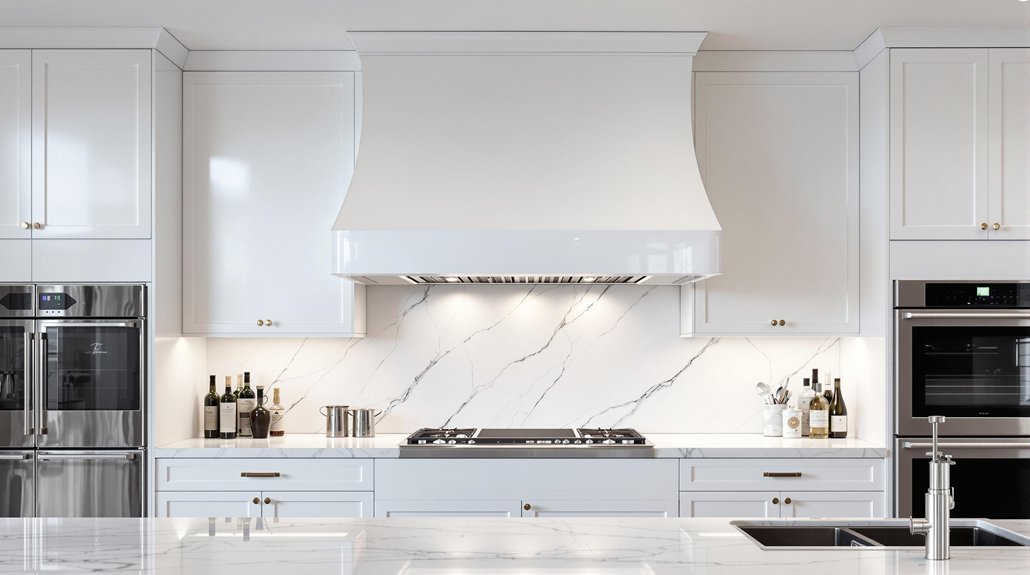
15 White Kitchen Hood Ideas That Add a Stylish Focal Point
White kitchen hoods create striking focal points by blending industrial exposed ductwork, graceful curved lines, and minimalistic profiles for a refined, sculptural presence. Variations include matte or glossy finishes, wood paneling for seamless cabinetry integration, bold protruding accents, or distinctive trim details. Contrasts with marble backsplashes and coordinated appliance finishes enhance the visual impact, balancing light and layering organic textures. Each design harmonizes form with function, offering a fresh perspective on introducing personality and movement into the kitchen—discover how versatility defines each approach.
Key Takeaways
- Choose a minimalistic white kitchen hood with clean lines to create a modern, airy focal point that amplifies light and spaciousness.
- Opt for a curved or arched white hood with bold accents or metal trim to introduce sculptural interest and visual contrast.
- Integrate the hood with wood paneling to achieve a seamless, elegant look that blends into cabinetry while adding warmth and texture.
- Highlight the backsplash by using a subtle white hood, or extend backsplash materials onto the hood for cohesive, artful impact.
- Coordinate the white hood’s finish with appliances and cabinetry to ensure a unified, sophisticated, and timeless kitchen design.
Leave It Exposed for an Industrial Touch
By opting to leave the kitchen hood exposed, designers can introduce an unmistakable industrial edge, particularly effective in spaces with tall vaulted ceilings that amplify architectural drama.
This approach leverages the hood as a sculptural element, allowing its form and function to command attention. Open ductwork, especially when finished in matte black, reinforces the industrial aesthetic and contributes a cohesive visual rhythm throughout the kitchen.
The interplay between the exposed hood and matching ductwork adds both depth and architectural intrigue, transforming the utilitarian into the decorative.
Eschewing traditional cabinetry or boxed enclosures, this technique results in a kitchen that feels open, airy, and unapologetically modern.
The hood becomes a bold, intentional statement—anchoring the space and elevating the kitchen’s overall design narrative.
Add Dimension With Curved Lines
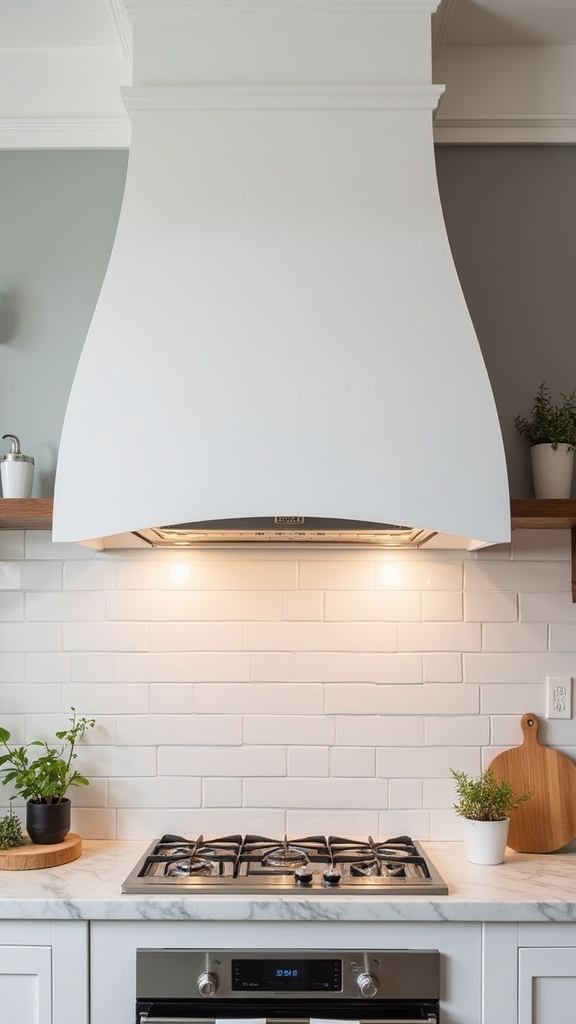
While exposed kitchen hoods establish a bold, industrial presence, introducing curved lines offers a softer, more sculptural dimension to the space.
The integration of curved lines in a kitchen hood design disrupts the dominance of linear cabinetry and countertops, infusing the kitchen with visual interest and architectural dynamism. A white kitchen hood with gentle arches or sweeping contours can provide a stunning contrast against a dark backsplash, amplifying the focal point without overwhelming the room’s aesthetic.
These fluid forms work seamlessly across design styles—traditional, transitional, or modern—allowing for a personalized yet cohesive look. By incorporating curves, a kitchen hood not only becomes a sophisticated centerpiece but also contributes to a more inviting, harmonious environment, subtly elevating the overall ambiance of the kitchen.
Give It an Edge With Bold Accents
Although a white kitchen hood exudes timeless simplicity, integrating bold accents can transform it into a striking design statement. Protruding curved features introduce sculptural interest, enhancing traditional silhouettes with a invigoratingly contemporary edge.
Incorporating a contrasting marble backsplash amplifies the hood’s role as a focal point, as the interplay of texture and color draws the eye. A distinctive bottom edge, whether subtly beveled or dramatically flared, creates a visual pause, anchoring the feature within the kitchen’s architectural context.
Decorative trim and hardware in bold metals—such as brushed brass or matte black—elevate the hood, offering a sophisticated accent. Surrounding cabinetry or countertops in statement hues or patterns further emphasize the hood’s edge, ensuring it remains the kitchen’s most prominent and stylish centerpiece.
Keep It Minimal for a Clean Look
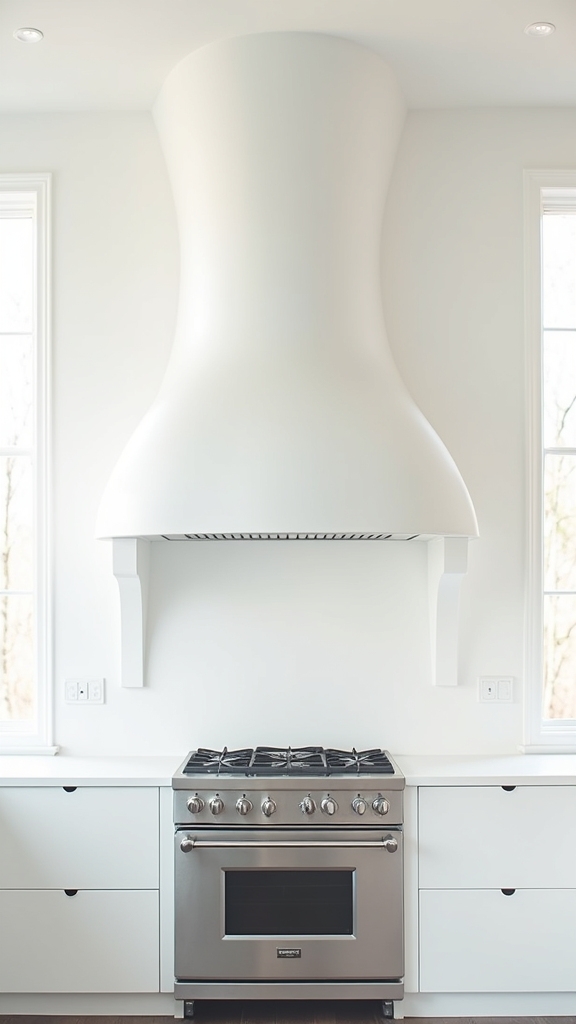
When a white kitchen hood embraces minimalism, the result is a harmonious integration with surrounding surfaces, fostering a seamless visual flow.
A minimalistic range hood design is characterized by clean lines, understated profiles, and a lack of ornate detailing, ensuring the hood does not overpower the kitchen’s aesthetic. This streamlined approach allows architectural features such as bespoke cabinetry or dramatic stone backsplashes to remain the focal point, rather than competing for visual attention.
The use of white in a minimalistic range hood design further amplifies natural and artificial light, contributing to an airy, spacious ambiance. Minimal designs evoke a sense of tranquility and refinement, aligning with contemporary kitchen trends that prioritize both elegance and functionality.
The result is a timeless, cohesive kitchen environment.
Work With the Windows for Unique Placement
Capitalizing on natural light and panoramic views, positioning a white kitchen hood in front of expansive windows transforms the range area into a luminous focal point.
This innovative approach to Kitchen Range Hood Ideas not only maximizes daylight but also visually expands the kitchen, merging the boundaries between indoor and outdoor spaces.
Distinctive choices, like a sculptural lilac marble hood, introduce a “floating” effect, highlighting both architectural sophistication and the beauty of the surrounding view.
A well-considered window-and-hood arrangement balances essential ventilation with refined aesthetics, ensuring the cooking zone remains a beautiful focal point within the culinary space.
- Awe-inspiring vistas enhance everyday routines.
- Sunlit surfaces foster a serene, uplifting ambiance.
- Seamless integration of function and beauty inspires admiration.
Install Corbels on the Sides for Classic Charm
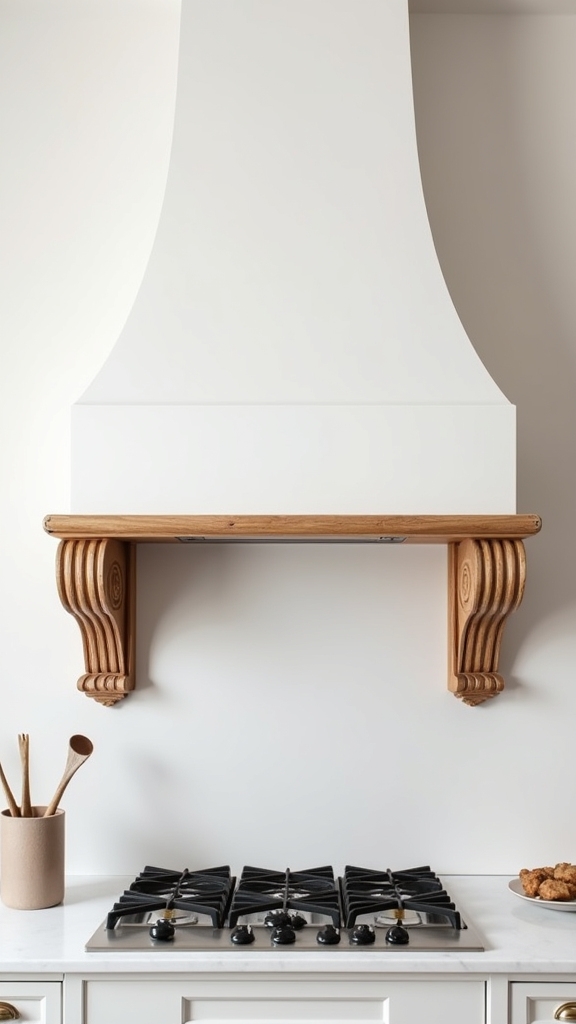
Beyond harnessing natural light and panoramic vistas, another approach to elevating a white kitchen hood centers on the application of architectural embellishments. Installing oversized decorative corbels on each side of the hood introduces a striking visual impact, infusing the space with classic charm. These sculptural elements, often crafted from wood and finished to match adjacent cabinetry, serve as both functional supports and ornamental anchors. Corbels articulate the changeover between the hood and surrounding millwork, breaking linear monotony and adding dimensional depth. Their intricate profiles—ranging from scrollwork to simple brackets—allow for nuanced stylistic blending, bridging traditional and modern aesthetics seamlessly. Incorporating elements like geometric paneling can further enhance the visual and functional dynamics of the space. As a result, the white hood becomes a cohesive focal point, offering visual interest and architectural gravitas within the kitchen’s design narrative.
Disguise It With Wood Paneling
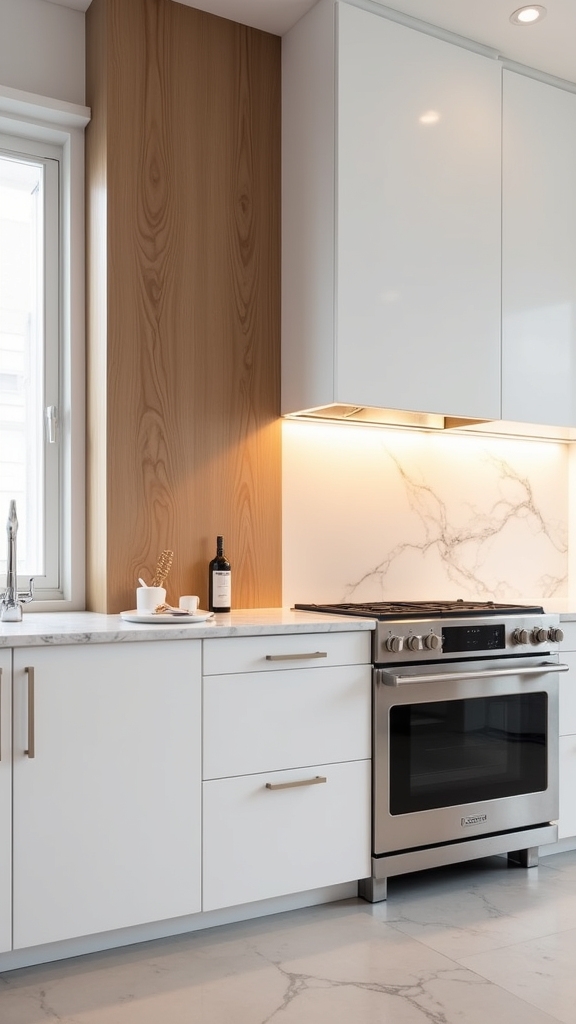
Disguising a white kitchen hood with wood paneling achieves seamless cabinetry integration, resulting in a unified and harmonious visual flow.
This technique imparts an understated elegant appeal, allowing the hood to recede while elevating the sophistication of the space.
The subtlety of wood paneling creates a refined backdrop that supports both classic and contemporary kitchen aesthetics.
Seamless Cabinetry Integration
Cohesion defines the visual narrative when a kitchen hood disappears behind meticulously crafted wood paneling, creating the illusion of uninterrupted cabinetry. This technique exemplifies the art of seamless cabinetry integration, where the range hood blends effortlessly into the surrounding cabinet architecture.
In kitchen design, wood paneling applied to the hood can be tailored to reflect the same finishes, moldings, and hardware as adjacent cabinets, ensuring a harmonious and unified aesthetic. The subtlety of this approach not only enhances the space but also allows the kitchen’s architectural details to shine without distraction.
For those seeking a refined composition, this method provides a balance of form and function.
- Experience tranquility with uninterrupted cabinet lines.
- Revel in the warmth of custom wood finishes.
- Savor the harmony of masterfully unified kitchen design.
Understated Elegant Appeal
Subtlety defines the understated elegance achieved when a white kitchen hood is concealed behind custom wood paneling. This approach allows the hood to blend harmoniously with the surrounding cabinetry, resulting in a visually seamless integration that enhances spatial cohesiveness.
Wood paneling introduces a tactile warmth and organic texture, transforming the kitchen into a more inviting and comfortable environment. By disguising the kitchen hood, designers avoid drawing excessive attention to the appliance, allowing other architectural and decorative features to stand out.
The versatility of wood paneling enables personalized expression through a variety of finishes—be it natural oak, rich walnut, or painted surfaces—each tailored to complement the kitchen’s broader aesthetic. This technique guarantees the kitchen hood functions efficiently without compromising the room’s refined, unified appeal.
Let the Backsplash Shine
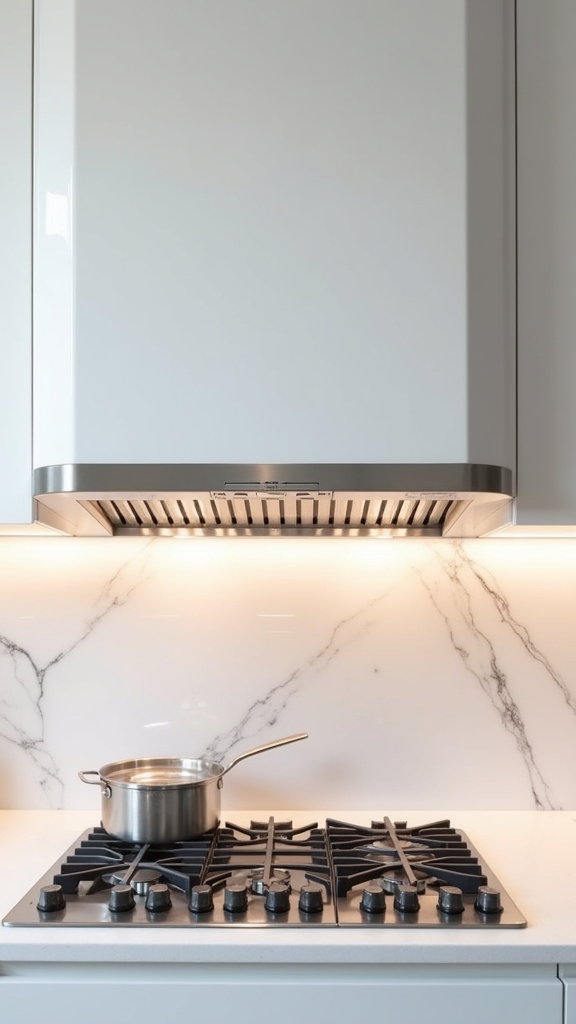
A thoughtfully designed kitchen often positions the backsplash as a focal point, especially when hand-painted tiles or intricate mosaics are involved.
When the range hood is understated and seamlessly integrated, it allows the artistry of the backsplash to command attention, celebrating craftsmanship and design intent.
Glass protection guarantees the delicate surfaces remain pristine, elevating the impact of each brushstroke or pattern without visual interference.
The interplay between a subtle white range hood and a statement backsplash fosters a sense of cohesion while drawing the eye to the kitchen’s most artistic feature.
A quiet white range hood lets a bold backsplash shine, creating unity and highlighting the kitchen’s true centerpiece.
- Marvel at the beauty of hand-painted tiles, where every detail is preserved and celebrated.
- Appreciate the harmony achieved when the range hood enhances, not overshadows, the backsplash.
- Experience the sophistication that arises from meticulous design and intentional restraint.
Light wood countertops add subtle warmth to white kitchens, balancing natural beauty with modern elegance.
Accentuate It With Metal Trim

Accentuating a white kitchen hood with metal trim introduces refined texture and a tailored silhouette, instantly elevating its visual presence.
Brass accents inject warmth and a sense of luxury, while strategic incorporation of mixed metals such as stainless steel establishes a dynamic interplay of contrast.
This technique not only unifies metallic elements throughout the kitchen but also transforms the hood into a sophisticated focal point.
Elevate With Brass Accents
When brass accents are introduced to a white kitchen hood, the interplay of luminous metal against a crisp backdrop instantly enhances the design narrative. This refined detail transforms range hoods into sculptural elements, infusing the space with a sense of warmth and understated luxury.
Brass trim, whether outlining edges or forming geometric inlays, provides striking definition that amplifies architectural lines and highlights the hood’s silhouette. The trending use of brass in kitchen design bridges classic and contemporary styles, while harmonizing with hardware and fixtures for a cohesive visual language.
- Inviting Warmth: Brass accents add a golden glow, creating an inviting and heightened atmosphere.
- Architectural Emphasis: Defined brass lines draw attention to the hood’s elegant form.
- Unified Sophistication: Cohesive metallic elements result in a polished, designer-curated kitchen.
Mix Metals for Contrast
Some of the most compelling white kitchen hood designs leverage the interplay of mixed metals, introducing metal trim—such as polished brass, matte black, or brushed copper—to accentuate the hood’s crisp silhouette.
This technique infuses range hoods with visual intrigue, transforming them into striking focal points that seamlessly harmonize with a kitchen’s broader metallic palette. By juxtaposing warm and cool finishes, designers achieve a balanced yet dynamic aesthetic, ensuring the white foundation remains fresh while the metal trim offers definition and sophistication.
Integrating mixed metals on range hoods also supports continuity with cabinet hardware, lighting, and appliances, fostering a cohesive environment.
The versatility of metal trim empowers homeowners to personalize their kitchen, experimenting with finishes that complement their unique style and enhance the overall design.
Match Your Other Appliances
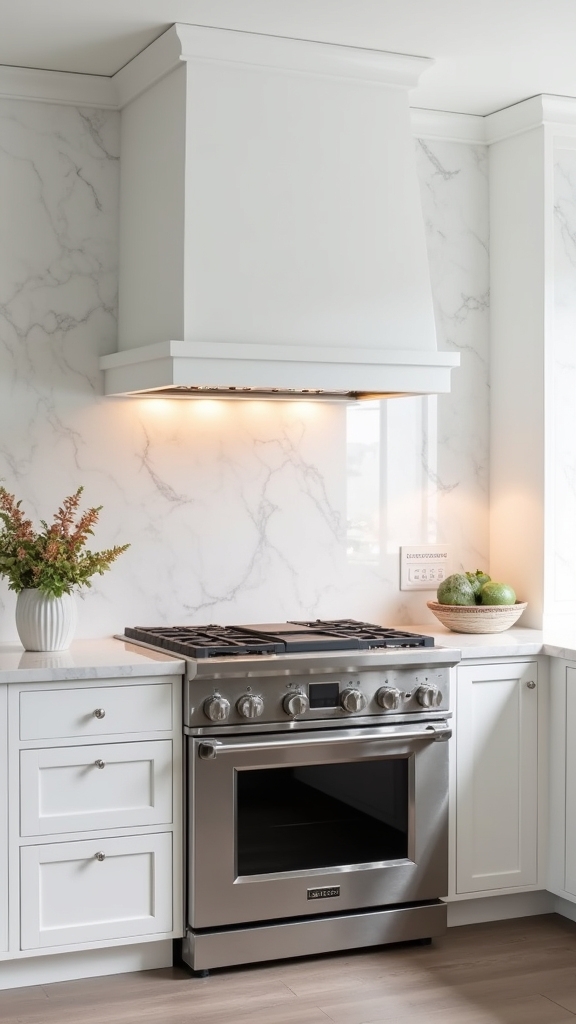
Cohesion in kitchen design is often achieved through deliberate coordination of appliance finishes and colors. Selecting a white range hood that matches other appliances, such as the dishwasher and refrigerator, establishes a cohesive aesthetic that feels thoughtfully curated and visually harmonious. Aligning finishes—whether glossy, matte, or textured—ensures the white range hood integrates seamlessly into the kitchen environment. This attention to detail not only streamlines the space but also provides flexibility for future decor changes. Metallic accents like brassy gold or silvery chrome can further enhance the modern elegance of a cohesive kitchen design.
- Visual Unity: Matching finishes and shades across appliances creates a sense of order and tranquility, making the space feel inviting.
- Polished Impact: A cohesive aesthetic enhances the kitchen’s overall sophistication, projecting a sense of deliberate design.
- Versatile Foundation: Uniform appliance tones offer adaptability, accommodating evolving trends and personal style shifts.
Blend It Into the Backsplash
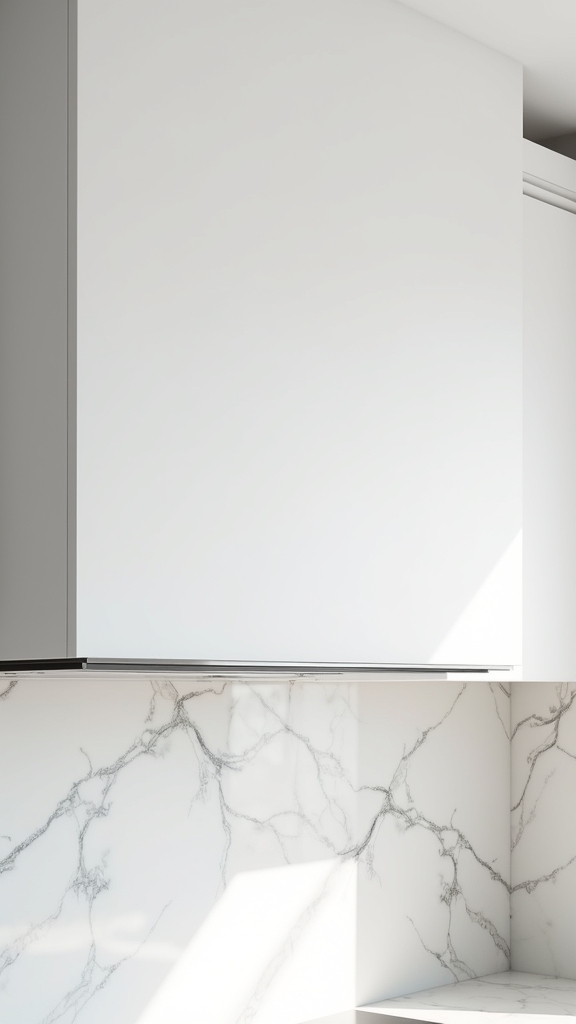
By extending the backsplash material onto the range hood, designers achieve a unified architectural element that visually anchors the kitchen. This seamless integration relies on meticulous alignment, particularly when utilizing statement materials like marble or premium tile, where veining and pattern continuity are essential.
The result is a sophisticated, cohesive visual flow that enhances the kitchen’s overall aesthetic. The range hood becomes an unobtrusive extension of the backsplash rather than a standalone feature, reducing visual clutter and fostering a sense of spaciousness and order.
This technique not only delivers a luxurious, textural dimension but also maintains functionality, as durable surfaces remain easy to clean. The approach exemplifies a refined, minimalist sensibility, perfect for contemporary white kitchens seeking understated elegance and architectural harmony.
Use Wood as an Accent
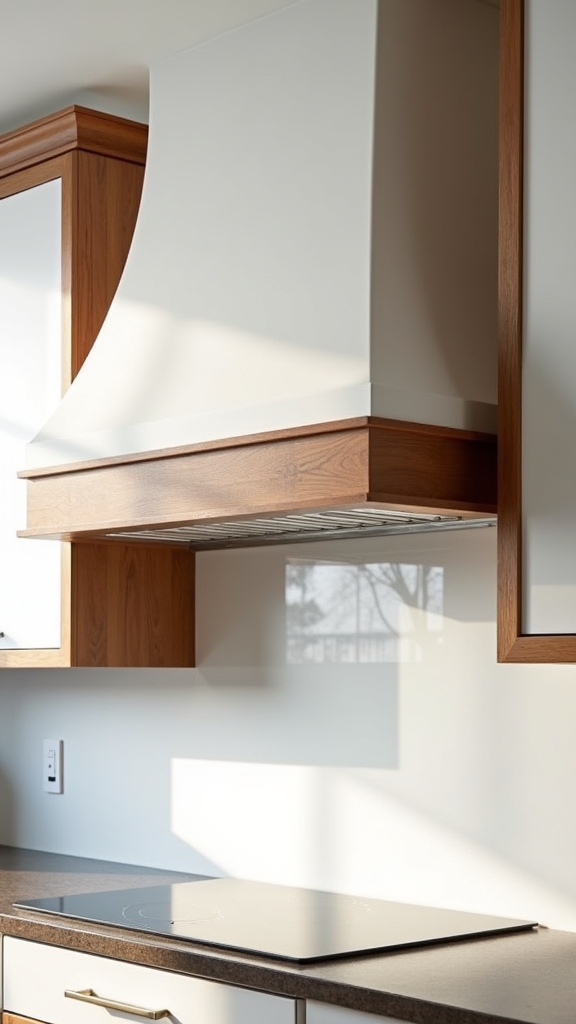
Introducing wood as an accent on a white kitchen hood infuses the space with organic warmth and tactile interest. Carefully selected wood trim or paneling fosters visual cohesion, harmonizing the hood with surrounding cabinetry and architectural details. This approach balances crisp white surfaces with natural texture, resulting in a kitchen that feels both contemporary and inviting. Incorporating rustic wooden planks into the design can further enhance the kitchen’s cozy charm, providing both functional and stylish benefits.
Warmth Through Wood Accents
A touch of natural wood, thoughtfully integrated as an accent around a white kitchen hood, infuses the space with warmth and visual interest.
Designers often choose wood trim to outline the contours of a white hood, introducing organic texture that softens the crisp, clean lines of modern cabinetry.
This synergy between sleek finishes and tactile materials strikes a balance between contemporary elegance and rustic charm.
Whether employing lightly stained oak or deeper walnut, wood accents serve as a compelling counterpoint to the pristine white surface, drawing the eye and anchoring the room’s focal point.
- The gentle contrast between wood trim and a white hood evokes a sense of calm and comfort.
- Textural variation adds depth, creating a more layered and inviting atmosphere.
- Subtle wood details imbue the kitchen with timeless, handcrafted appeal.
Harmonizing With Kitchen Elements
Building upon the inviting warmth lent by wood accents, successful kitchen design often hinges on the integration of these elements with surrounding features.
Stained wood trim, when applied thoughtfully to a white kitchen hood, serves as a refined shift point, drawing the eye without overpowering the space. This subtle incorporation not only enhances the hood as a focal point but also establishes a seamless connection with white cabinetry and other kitchen fixtures.
Wood accents introduce tactile contrast and visual depth, mitigating the starkness of an all-white palette while infusing the environment with natural elegance.
Align It With Open Shelves
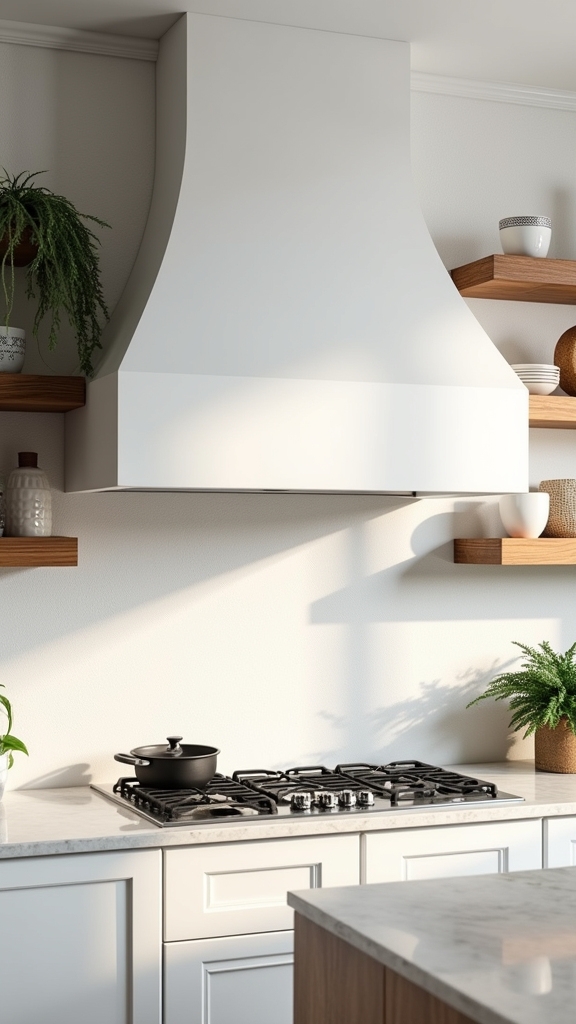
Aligning a white kitchen hood with open shelves establishes a harmonious visual rhythm, seamlessly merging functional elements with contemporary aesthetics.
This configuration achieves a visually balanced composition, where the crisp geometry of a basic rectangular hood complements the linear simplicity of open shelving. The white kitchen hood acts as a striking centerpiece, while the open shelves offer both practical storage and curated display opportunities, reinforcing the kitchen’s cohesive narrative.
This alignment introduces a sense of airiness and sophistication, inviting the eye to travel fluidly across the space. Integrating these elements maximizes both function and style, creating a kitchen that feels open, organized, and welcoming.
- Experience the serenity of uncluttered design.
- Savor the seamless integration of form and function.
- Delight in a kitchen that inspires both creativity and calm.
Trim Off the Top for a Seamless Transition
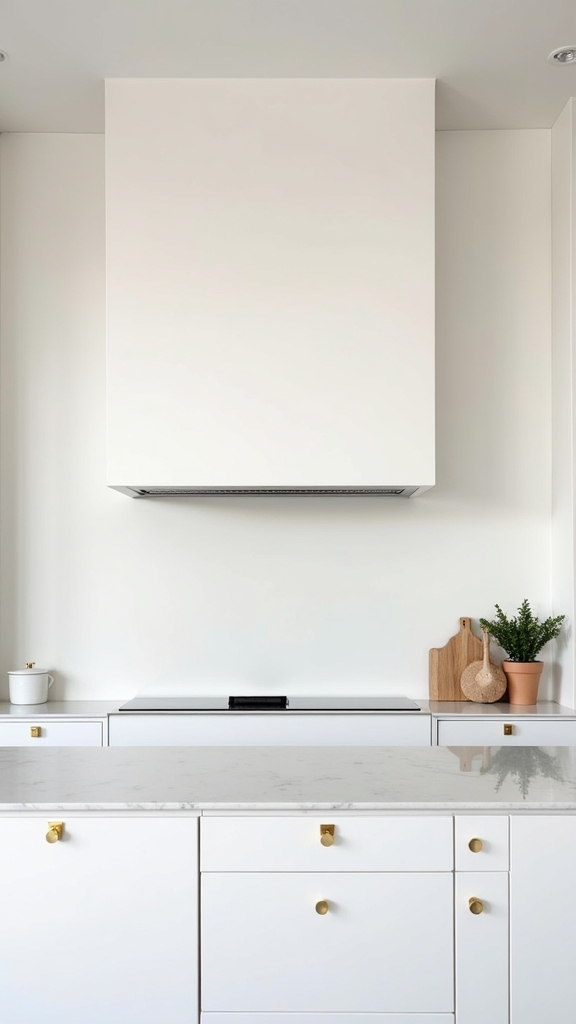
While the interplay between white kitchen hoods and open shelving establishes a balanced visual narrative, attention to the hood’s upper boundary refines the overall aesthetic.
Introducing a trim at the top of the hood that matches the ceiling material enables a seamless connection, allowing the hood to integrate effortlessly into the architecture. This design detail not only unifies the hood with the kitchen’s envelope but also subtly raises the perceived ceiling height, resulting in a more expansive and airy environment.
The trim serves as an elegant finishing touch, minimizing visual disruption and ensuring the range hood complements other key features. By focusing on this junction, designers achieve a harmonious composition where the hood remains a stylish focal point without overwhelming the space or competing for attention.
Elevate Stainless Steel With a White Finish
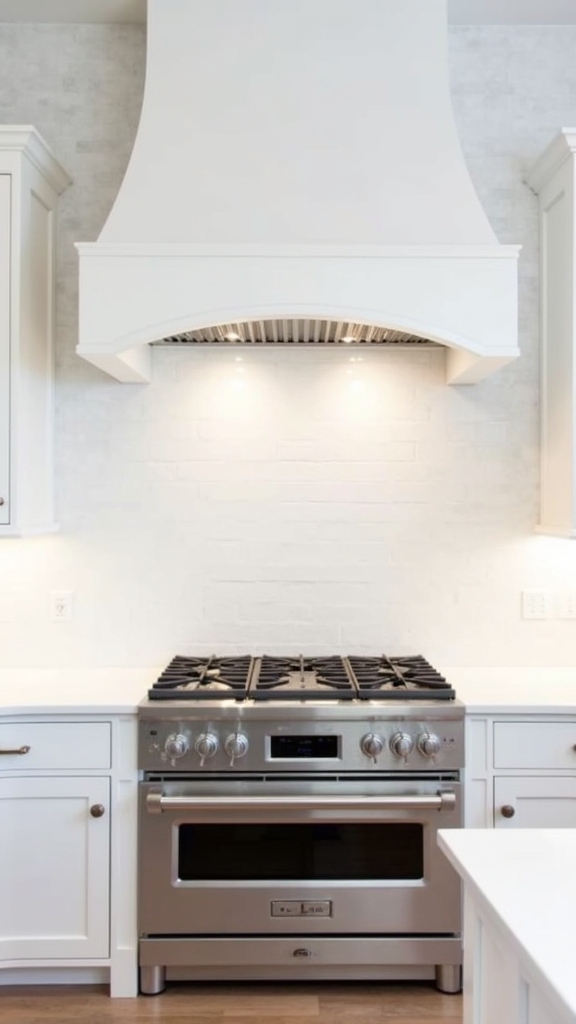
Though stainless steel remains a staple in modern kitchen design for its durability and industrial appeal, applying a white finish to this material enhances its visual impact and versatility.
The sleek, pristine surface of a white-finished stainless steel hood not only coordinates beautifully with white cabinetry, but also amplifies ambient light, creating a luminous, welcoming kitchen environment.
A white-finished stainless steel hood brightens the kitchen, seamlessly pairing with white cabinetry for a light-filled, inviting atmosphere.
This finish maintains the resilience and easy-clean benefits of stainless steel while offering a sophisticated touch that bridges both contemporary and traditional aesthetics.
When juxtaposed with darker elements—such as dramatic black backsplashes or cabinetry—the effect is visually compelling, delivering a striking focal point.
Two-tone designs in kitchen spaces can enhance the depth and sophistication of the overall design when paired with strategic color combinations.
- Experience the uplifting effect of increased brightness and cohesion.
- Appreciate the effortless maintenance and enduring durability.
- Delight in the bold contrast and timeless adaptability in any kitchen style.
Frequently Asked Questions
How Do I Keep a White Kitchen Hood Clean and Stain-Free?
Maintaining a pristine white kitchen hood requires consistent cleaning techniques such as using mild detergents, microfiber cloths, and degreasers. Stain prevention is optimized by promptly wiping splatters, applying protective sealants, and ensuring efficient ventilation to minimize residue buildup.
What Materials Are Best for a Durable White Hood?
For a durable white hood, designers recommend ceramic finishes for their stain resistance and easy maintenance, while stainless steel offers structural integrity and longevity. Both materials provide a sleek backdrop, enhancing modern kitchen aesthetics and ensuring lasting visual appeal.
Can a White Hood Work in Small Kitchens Without Overwhelming the Space?
Integrating a white hood in small kitchens supports space optimization, as its light hue visually expands the area. Thoughtful color coordination with cabinetry and backsplashes guarantees the hood remains a subtle, harmonious element rather than overwhelming the compact space.
Are There Energy-Efficient Options for White Kitchen Hoods?
When considering kitchen ventilation, energy-efficient white kitchen hoods are available featuring high energy ratings and eco friendly options. Advanced models utilize variable-speed motors, LED illumination, and recirculating filtration systems, aligning with contemporary sustainability standards and modern design sensibilities.
How Do I Choose the Right Size White Hood for My Cooktop?
Selecting the appropriate hood size involves measuring the cooktop width and considering the user’s cooking style. Experts recommend a hood extending 3 inches beyond each side of the cooktop to maximize airflow efficiency and capture culinary byproducts effectively.
Conclusion
A white kitchen hood seamlessly blends functionality with visual appeal, serving as both a practical appliance and a design centerpiece. Whether accentuated with bold trim, softened by curves, or juxtaposed with natural wood, these hoods can transform a kitchen’s atmosphere. Through thoughtful integration—be it aligning with open shelves or embracing minimalist profiles—each approach showcases the hood as a tailored focal point. Ultimately, a white hood offers versatility, complementing a spectrum of kitchen aesthetics and elevating the overall space.
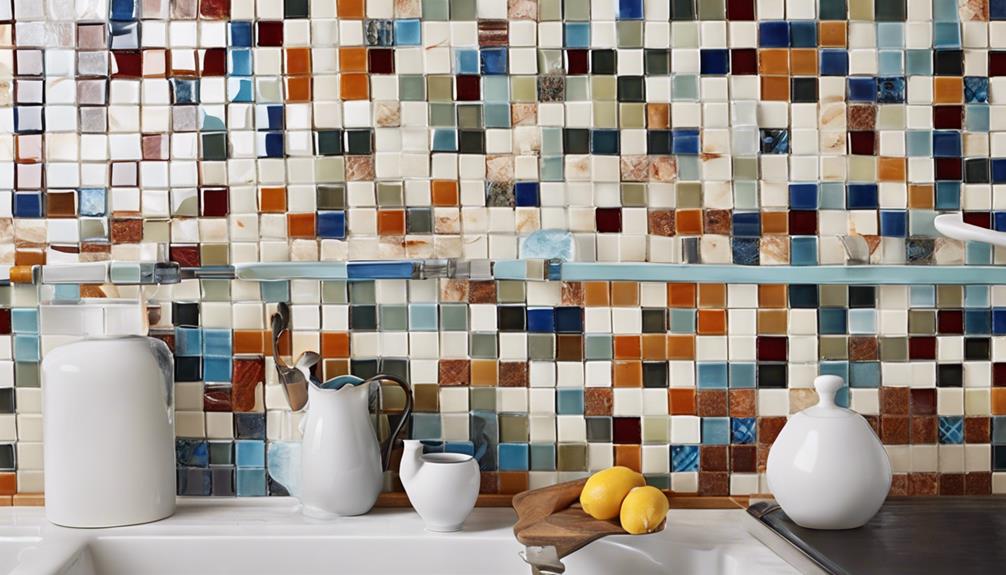
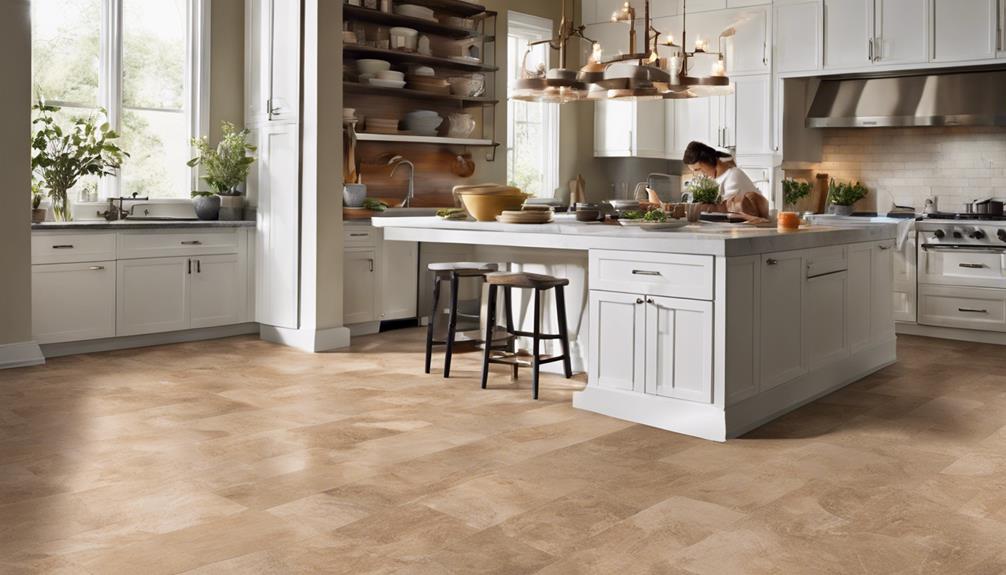
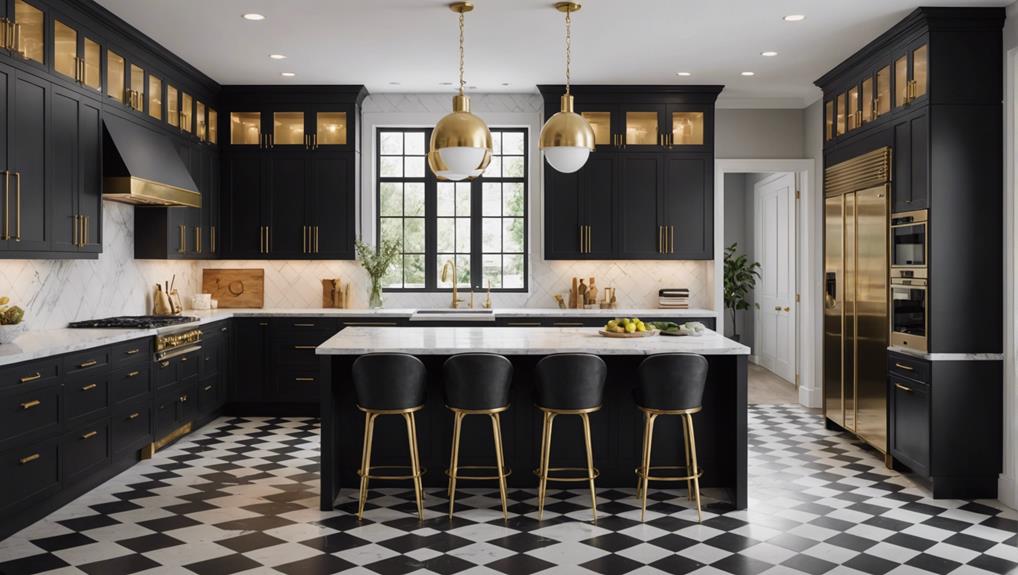
Leave a Reply